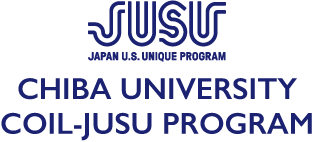Contemporary Religion in Japan
実施大学(学部)
Partner university (faculty)
千葉大学国際教養学部 ニューヨーク州立大学ストーニーブルック校
College of Liberal Arts and Sciences, Chiba University and Stony Brook University, The State University of New York
授業日程
Class schedule
千葉大学国際教養学部
College of Liberal Arts and Sciences
2019年度第5ターム月3,4限
Monday, 3rd-4th Periods, Term 5, 2019
ニューヨーク州立大学ストーニーブルック校
Stony Brook University, The State University of New York
2019年度第5ターム月3,4限+受け入れ期間:2020年1月5日~15日
Monday, 3rd-4th Period, Term 5, 2019+Acceptance Period: January 5-15, 2020
時差
Time difference
14時間
14 hours
授業目的
Class objectives
現代日本における宗教と社会の関係について考える・学ぶこと
Thinking and learning about the relationship between religion and society in contemporary Japan
授業内容
Class content
本科目は普遍教育科目(教養展開科目)「宗教と社会」(JS)としても二言語(英語・日本語)で提供されている。宗教の社会的な位置を考察する内容としている。政治活動する宗教団体、3.11以降支援活動に力を入れ始めた特定の宗教観をもつNGO、また宗教原理主義が原因とされる暴力・テロ事件などの日本の事例を紹介しながら、宗教の現代社会的な役割を批評的に考えることを目指している。本授業はそれぞれの課題に関する「答え」・「解決」など与える場ではなく、学生が自分の観点や議論を見つけるために知識やスキルを学ぶ科目である。
This course is offered bilingually (Japanese and English) as a core course in "Religion and Society" (Japanese Studies) that considers the social positioning of religion. The course aims to critically consider the contemporary social roles of religion while introducing examples in Japan such as religious organizations engaged in political activity, nongovernmental organizations with specific religious views that are actively involved in providing support activities after the Great East Japan Earthquake, and incidents of violence and terrorism caused by religious fundamentalism. The course is not intended to provide "answers" or "solutions" to the issues arising therewith, but to help students gain the knowledge and skills needed to find their own perspectives and theories.
授業実施形態
Class format
非同期型
Asynchronous
使用ツール
Tools used
YouTube、メール
YouTube and e-mail
Program for SBU
Religion and Society in Contemporary Japan
January 5 to 15, 2020
[pre-departure from US online lectures]
SBU students will have access to the readings and video files of lectures conducted in the course Religion and Society (Term 5, Monday 4th and 5th period), which begin at Chiba University on Monday 9 December. This is a general introductory course held in both Japanese and English for students of all departments of the university.
SBU students will also be asked to complete the brief worksheet that ChibaU students taking this same class will be completing at the end of each lecture. These worksheets are used to launch discussions in the following week's lecture, so SBU students will have the chance to get a sense of how their work compares to and impacts on the rest of the class before the come to Japan.
Online lecture01 (9 Dec. 2019): "Why study about religion?"
Reading: Dolce, Lucia. 2015. The practice of religion in Japan: An exploration of the state of the field. In James Babb. The SAGE Handbook of Modern Japanese Studies. London: Sage, pp.33-62.
Online lecture02 (16 Dec. 2019): "Religion and politics 1: The separation of religion and politics"
Reading: Helen Hardacre. 2017. Shinto: A History. Oxford: Oxford University Press, chapter 14.
[short study program in Chiba] (5~15 January 2020)
* length of academic content estimated at 5~6 hours per day incl. transit time
- January 5 (Sun): arrival in Japan.
- January 6 (Mon): orientation at ChibaU and participation in Religion&Society class (topic: "Religion and social engagement 1: Religion in Japan after 3.11")
Reading: McLaughlin, Levi. 2016. Hard lessons learned: Tracking changes in media presentations of religion and religious aid mobilization after the 1995 and 2011 disasters in Japan. Asian Ethnology 75(1): 105-137. - January 7 (Tue): Lecture on Shinto("Religion and modern/contemporary Japan: the case of Meiji Shrine")+ guided visit of Meiji Shrine
Reading: Azegami, Naoki (trans. Ioannis Gaitanidis). 2012. "Modernization" (gendaika) and the formation of religious nationalism in pre-war Japanese society." [This paper was originally published as a "Kingendaishi bukai kyōdō kenkyū hōkoku" (Report of Collaborative Research by the Working Group on Modern and Contemporary History) in Nihonshi kenkyū (Journal of Japanese History) vol. 582 (February 2011), pp.96-120.] - January 8 (Wed): Lecture on Buddhism ("Popular Buddhism in Japanese history: the case of Narita-san") +guided visit of Narita-san
Reading: Covell, Stephen G. 2012. Money and the temple: Law, taxes and the image of Buddhism. In Inken Prohl and John Nelson. 2012. Handbook of Contemporary Japanese Religions. Leiden: Brill, pp.159-176. - January 9 (Thu): Tour of Kyoto temples with guide
- January 10 (Fri): Tour of Kyoto temples with guide
- January 11 (Sat): visit of Chiba-shrine with all students from Religion and Society class
Reading: "Heisei Shinto", Chapter 16 + Appendix (pp.509-556) in Helen Hardacre. 2017. Shinto: A History. Oxford: Oxford University Press. - January 12 (Sun): free day
- January 13 (Mon): "Supirichuariti (spirituality) and religion in alternative Japan" (by Gaitanidis)
Reading: Ioannis Gaitanidis. 2012. Spiritual therapies in Japan. Japanese Journal of Religious Studies 39(2): 353-384. - January 14 (Tue): participation in Religion and Society class (topic: "Religion and social engagement 2: Religion and ethics")
- January 15 (Wed): departure from Japan
[post-return to US online lectures]
Online lecture04 (20 Jan 2020): "Religion and violence 1: The AUM affair"
Reading: Reader, Ian. 2012. Globally Aum: The Aum affair, counterterrorism, and religion. Japanese Journal of Religious Studies 39(1): 179-198.
Online lecture05 (27 Jan 2020): "Religion and violence 2: Symbolic empowerment"
Reading: Baffelli, Erica and Ian Reader. 2012. Editors' Introduction. Impact and Ramifications: The Aftermath of the Aum Affair in the Japanese Religious Context. Japanese Journal of Religious Studies 39/1:1-28 (only up to page 20)
Online lecture06 (3 Feb 2020): final debate

